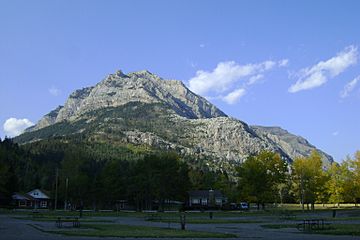Mount Crandell facts for kids
Quick facts for kids Mount Crandell |
|
|---|---|

Mouint Crandell seen from Waterton Town Campground
|
|
| Highest point | |
| Elevation | 2,381 m (7,812 ft) |
| Prominence | 781 m (2,562 ft) |
| Parent peak | Mount Blakiston (2932 m) |
| Listing | Mountains of Alberta |
| Geography | |
| Location | Alberta, Canada |
| Parent range | Clark Range Canadian Rockies |
| Topo map | NTS 82H04 |
| Geology | |
| Age of rock | Cambrian |
| Type of rock | sedimentary rock |
| Climbing | |
| Easiest route | Scrambling |

Mount Crandell is a tall mountain peak, about 2,381 meters (7,812 feet) high. It is located in Waterton Lakes National Park in Alberta, Canada. This park is part of the amazing Canadian Rockies mountain range.
Mount Crandell stands just north of the small town of Waterton. Its closest taller neighbor is Bertha Peak, which is about 2.94 kilometers (1.83 miles) to the south-southwest.
Contents
The Story Behind the Name
Who Was Edward Crandell?
Mount Crandell was given its name in 1914. It was named after Edward H. Crandell, who was an important person in the early oil industry in Calgary. He helped develop the oil business in the region.
Making the Name Official
The mountain's name became official in 1943. This was decided by the Geographical Names Board of Canada. This board is responsible for naming places across Canada.
How Mount Crandell Was Formed
Understanding Sedimentary Rock
Like many mountains in Waterton Lakes National Park, Mount Crandell is made of a type of rock called sedimentary rock. This rock forms over millions of years from layers of mud, sand, and tiny bits of plants and animals. These layers get pressed together and harden.
A Journey Through Time
The sedimentary rock that makes up Mount Crandell was laid down a very long time ago. This happened during periods known as the Precambrian to Jurassic eras. Imagine ancient shallow seas where these layers slowly built up!
The Laramide Orogeny
Later, a huge event called the Laramide orogeny happened. This was a time when the Earth's crust moved and pushed these rock layers. It caused the older sedimentary rock to be pushed up and over younger rock layers. This incredible force created the mountains we see today, including Mount Crandell.
Weather and Climate
What is a Subarctic Climate?
Mount Crandell is in a subarctic climate zone. This means it has very cold and snowy winters. Summers are usually mild, not too hot.
Winter Temperatures
In winter, temperatures can drop below -20 degrees Celsius (-4 degrees Fahrenheit). With the wind, it can feel even colder, sometimes below -30 degrees Celsius (-22 degrees Fahrenheit).
Water Flow
The snow and rain that fall on Mount Crandell eventually melt and flow down the mountain. This water drains into Waterton Lake. From there, it flows into the Waterton River.



